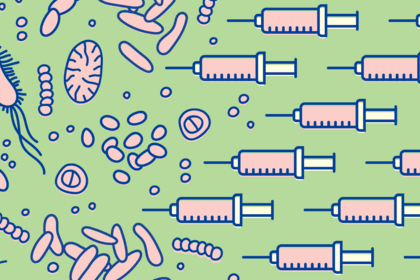
Summary
How has the world responded to the threat of antimicrobial resistance (AMR)?
- Progress has been made to address the issue of antimicrobial resistance. But more needs to be done to turn evidence from research findings into policy and action.
- There have been several strategies to minimise the impact of antimicrobial resistance.
- These include AMR global and national action plans, research reports on surveillance and epidemiology, community engagement and research and development to discover new antibiotics.
- The world can better respond to the crisis and protect people’s health with more ambitious action on AMR.
Modern medicine, public health and world economies: all are under threat from the growing burden of antimicrobial resistance.
Antimicrobial resistance happens when microbes stop responding to the drugs used against them. This leads to drug-resistant infections which are much harder, or impossible, to treat.
Almost five million people are estimated to die with a drug-resistant infection per year, and mortality rates are higher in low- and middle-income countries.
By 2035, the global annual cost of antimicrobial resistance is expected to reach US $855 billion. That includes the cost of treating drug-resistant infections and the impact of increased morbidity and mortality on workforces.
While there have been significant efforts to address antimicrobial resistance over the last 15 years, we need a stronger global response to tackle the enormity of the threat.
What progress has been made in tackling antimicrobial resistance?
There has been notable progress in increasing our understanding of antimicrobial resistance (AMR) and surveillance of drug-resistant infections, as well as raising political attention and commitments to act on the issue.
Global collaboration
In 2009, a Transatlantic Taskforce on Antimicrobial Resistance was formed between experts from Canada, Norway, the EU, the UK and the US. They collaborate to strengthen efforts to address the urgent threat of drug-resistant infections.
The following year, three leading health organisations – the World Health Organization, Food and Agriculture Organization and World Organisation for Animal Health – formed a Joint Tripartite to support the global response to AMR through a One Health approach. The approach recognises the connections between the health of humans, animals and our environment. It calls on governments and experts across sectors around the world to respond together to health threats. This approach is key for AMR because of the speed and scale at which drug-resistant infections can spread. In 2022, the Tripartite became the Quadripartite with the addition of a new member, the United Nations Environment Programme.
Action plans
Several global political meetings since 2014 have brought attention to the issue of AMR. There have been three Ministerial Conferences on AMR, three Call to Action on Antimicrobial Resistance (AMR) Conferences, and two UN High Level Meetings on AMR.
Many of these have led to governments declaring new ambitions and renewing existing ones to tackle AMR. For example, the 2015 World Health Assembly launched a global action plan on AMR which led to the introduction of national action plans. Today, 178 countries have adopted an action plan. These propose actions to increase awareness, improve surveillance and research, reduce the number of infections, improve the use of antimicrobials and invest in new interventions.
Reports
Reporting on the extent of the problem of drug resistance is crucial to understanding and addressing it. In the 2016 Review on Antimicrobial Resistance, economist Jim O’Neill did just that, proposing solutions from an economic and social perspective. The review, supported by the UK government and Wellcome, had a global impact in driving awareness, advocacy and funding for AMR. However, little progress has been made on its core recommendation: incentives to develop new drugs, vaccines and diagnostics.
Other major publications include:
- The United Nations’s 2019 No Time to Wait report which highlights the need for urgent action on AMR.
- Wellcome’s 2020 The Global Response to AMR report which provides an update on recent developments and critical gaps in AMR.
- The Global burden of bacterial antimicrobial resistance in 2019 report. Published by The Lancet in 2022, and part funded by Wellcome, it presents the first global estimates of the impact of AMR. A second report on the global burden of bacterial antimicrobial resistance from 1990 to 2021 and forecasts to 2050, was published in 2024.
Surveillance
Effective surveillance systems are essential to capturing data on AMR. Data can help inform better interventions and health policies, as well as provide early warnings about emerging threats.
In 2015, the WHO launched the first global surveillance initiative – the Global Antimicrobial Resistance and Use Surveillance System (GLASS). It provides a standardised process for countries to share country level AMR data. As of February 2024, 137 countries participated in GLASS. However, there are data gaps in many low-income settings, where the highest burden of AMR exists.
At Wellcome, we’re also funding surveillance on AMR. For example, through A Clinically Oriented Antimicrobial Resistance Network (ACORN). It gathers clinical data on AMR from nine countries in Africa and Asia, with a focus on the use of data to inform patient treatment and improve outcomes. The project, which follows data collection recommendations from GLASS, aims to improve patient care and interventions for all.
Research and development
As microbes continue to develop resistance to existing treatments, we need to develop new ones. Over the years, we’ve supported many initiatives which aim to address the rising threat of drug-resistant bacteria through accelerating innovation in antibiotics, diagnostics and vaccines research and development. For example, the Global Antibiotic Research and Development Partnership (GARDP), Combating Antibiotic-Resistant Bacteria Biopharmaceutical Accelerator (CARB-X) and the AMR Action Fund.
We’re also funding the Centres for Antimicrobial Optimisation Network (CAMO-Net), which aims to form research partnerships across low-, middle- and high-income settings to minimise the global impact of AMR.
Community engagement
To be more effective, it's important that AMR research and interventions consider the needs and priorities of the communities most affected by drug-resistant infections.
Projects like the recent Wellcome-commissioned AMR Citizens’ Jury have worked to incorporate these perspectives into global public health agenda-setting activities.
AMR community engagement initiatives also help raise the public’s understanding of the issue and ensure policies are being implemented.
One example is Eh!woza in South Africa. Supported by Wellcome, the project runs workshops with young people in areas with high rates of HIV and tuberculosis (TB). Participants create music, poetry and videos to educate the public about the impact of the disease.
Another example is OASIS, a project which enables rural healthcare workers in India to record data on the supply and prescription of antimicrobials via an app. The project team aims to understand antibiotic use in India and encourage better practices for treating drug-resistant infections.
What needs to happen next?
While targets and initiatives like these exist, the translation of research findings into policy and action has been slow. We need:
- increased governance and accountability to reach national and global targets
- new, evidence-based strategies to slow the emergence and spread of drug-resistant infections
- more investment and incentives to enable the discovery of successful and sustainable drugs and vaccines
With collective and more ambitious action on AMR, the world can better respond to the crisis and protect people’s health.
Our work on antimicrobial resistance
At Wellcome, we support science to tackle the biggest barriers to controlling infectious disease in the most affected communities. This includes long-term investment in research to better understand the global burden of AMR and accelerate the development of new interventions.
We believe 2024 is a critical year to accelerate action on antimicrobial resistance. That’s why we’ve created a new policy brief on driving action on AMR.
It identifies opportunities to drive change in how governments respond collaboratively to AMR. It is designed to support discussions with and between governments in the lead-up to and following the 2024 UN General Assembly.



